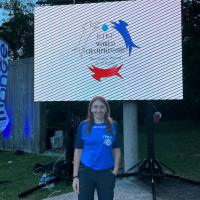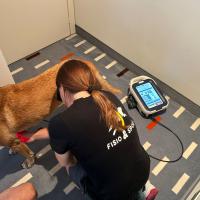She is the veterinarian entrusted with the preparation of the athletes by the Italian National IGP (Internationale Gebrauchshunde Prüfungsordnung) - a canine sports discipline recognised by the FCI (Italian International Dog Federation) which is divided into three sections: track, obedience and defence, editor's note - but also a specialist in physical medicine and canine sports medicine, a speaker at university courses and an author of international scientific publications.
“For several years now, not only have I known about laser therapy, but I have also used it as physical medicine therapy. However, I discovered MLS® Laser Therapy almost by chance, having purchased, back when, an old generation ASA device”.
From "chance" to conscious choice, the step may not be a short one.
What is convincing when adopting a therapy is generally the concrete results it provides, the patient's tolerability and also the type of disorders for which it is effective. In the specific case of MLS®, what convinced you?
All the aspects you mentioned, starting from its objective value in treating various sports pathologies such as, among others, tendinopathies. However, its advantages are also evident as a cool-down after training or a competition.
Can the use of MLS® also have positive repercussions in the pre-competition phase?
I believe that the use of Laser Therapy contributes to improving the athlete's sports performance, especially if it is used in the warm-up phase of a competition, a few hours before its start. But it is above all at the end of the competition that it is very valuable: it is a valid anti-fatigue method thanks to programs such as the "de-contracture" one in scan mode. Its contribution is more than secondary also when there are painful or inflamed areas.

How does the patient react to the therapy being applied?
Very well: even the most wary or sore patients are cooperative, so much so that I have never had to suspend the application because it was not tolerated. There is no doubt, however, that, to help carrying out the therapy, the use of certain measures can contribute to achieving the best results. For example, creating a comfortable environment, knowing how to identify the areas to be treated first, without neglecting the compensatory areas and, last but not least, the ability to put the dog or cat and the owner at ease, go in this direction.
Owners who already know the benefits of Laser Therapy or let themselves be guided by you?
Most owners come to my Centre with a vague knowledge of laser therapy: they have usually heard about it from friends or acquaintances who have used it for their animals. Some, however, do not know this practice and for this reason we explain it to them during the first visit, while the most suitable protocol for the patient is set up.
What is their reaction at the end of the treatment?
Being clear and professionally conveying what will be done, explaining the beneficial and possible negative effects, is the essential premise for generating a virtuous circle between owner and veterinarian. The relationship of trust that is established between owner-patient-doctor is instrumental in obtaining excellent results.
Can the use of MLS®, in addition to improving the patient's conditions, also have positive repercussions on daily outpatient practice?
From my experience, the answer is yes. In my clinic, moreover, all patients undergo a Laser Therapy session regardless of the problem they are experiencing. Its use is even more appropriate if they have to face situations such as perianal fistulas that are not healing or managing wounds that are difficult to heal. In these cases MLS® allows achieving important results. Its use for NAC (Non-Conventional Animals, editor's note) should not be underestimated either. I have had the opportunity to use it to treat claw, talon diseases in hawks, broken shells in turtles, wounds or nervous system pathologies in rabbits and the results have been very comforting.
Is there a specific case that you remember where MLS® contributed to solving a particularly complex disorder?
The case concerns an avalanche rescue dog suffering from severe biceps tendinopathy and its rupture. After having intervened, without success, by applying PRP, we subsequently opted to resorting to Laser Therapy twice a week. Using different protocols such as tendinopathy, tear and inflammation, together with a physical medicine program, the problem was resolved and the patient returned to its normal life.
A result that fully represents the real benefits of MLS®. Based on your experience, would you recommend it to a colleague?
MLS® Laser Therapy is an excellent solution, which achieves its highest performance levels if the person using it has good manual dexterity.


